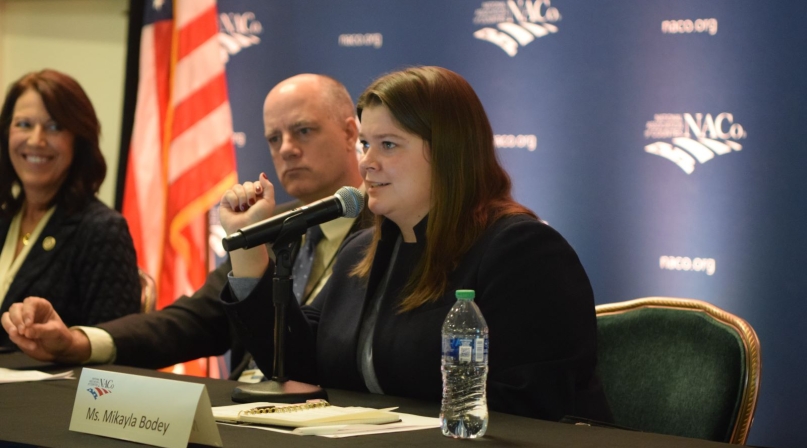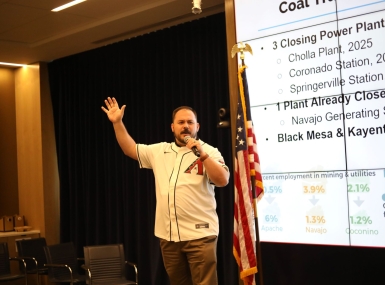Rural Action Caucus panel games out farm bill potential

Key Takeaways
Already more than a month past due, the farm bill’s fate remains up in the air as rural counties reach for clues about what to expect.
Although the five-year bill historically receives overwhelming bipartisan support in the end, the last three have also missed their deadlines, and changing dynamics in the House of Representatives over the last two months will test the negotiations in 2023 and potentially into 2024.
The 2018 farm bill, for example, passed in December, after its Sept. 30 expiration. Rural policy experts discussed the potential for the bill during the NACo Rural Action Caucus Symposium Nov. 4-6 in Greenbrier County, W.Va., the first time a major NACo conference or caucus meeting has been held in West Virginia.
“I think the question honestly becomes with the relationship in the House,” said Mikayla Bodey, senior professional staff for the Senate Agriculture, Nutrition and Forestry Committee.
“The House has a lot of really strong caucus rules about new programs, new authorizations, new spending offsetting with cuts and other sorts of programs, and we want to be respectful of those rules as much as we can, but of course not at the expense of delivering what we believe is meaningful rural policy,” Bodey noted.
Those policies, Cindy Axne said, would reflect the need to address significant changes since 2018, following the consequences of the COVID-19 pandemic, international conflicts that have disrupted food supplies and more.
Prior to joining the U.S. Department of Agriculture as a senior advisor, Axne represented Iowa in the House, after working in the state’s government.
In 2018, the farm bill authorized $867 billion over five years.
In May, the Congressional Budget Office released a baseline projection that the next farm bill will be authorized at $1.5 trillion over 10 years, based on mandatory farm programs and the Supplemental Nutrition Assistance Program, formerly known as food stamps.
“Something that we need to be looking for is how does this address things like climate resiliency, supply chain disruption, ensuring that our food systems are safe,” Axne said.
Bodey added that there is a need to support the continued work of small farmers and the chance to build new markets for those farmers.
She detailed some of Committee Chairwoman Debbie Stabenow’s (D-Mich.) takeaways from her home state, which include a drop in proportional population levels in rural communities and a nearly 50% drop in the number of family farms in the last 50 years. Bodey said Stabenow also sees opportunities that could play out elsewhere in rural America. The farm bill, Bodey said, could support those trends.
“Within the past few years, we’ve seen a lot of explosion in Michigan, of our tourism economy, a lot of continued growth around telework and folks being able to choose more independently where they want to live,” she said.
“We want to try to harness those things.”
All of the funding and programming, however, would do little if individuals and local governments can’t access them, and rural counties often don’t have the staff bandwidth to navigate applications and comply with reporting requirements. Making farm bill programming more user-friendly stuck out as low hanging fruit for Congress.
“For rural communities to be able to access those funds and those resources is challenging,” said Tony Pipa, a senior fellow at the Brookings Institution who leads the non-profit policy organization’s Reimagining Rural Policy initiative.
“Looking at what’s in there for rural in those particular bills — we’re counting more than $460 billion worth of resources that could be really significant for rural places…so having the capacity and the technical assistance and what’s necessary to be able to make sure that we’re maximizing the public benefit of those funds and getting them to the places that can use them the most I think ought to be a big part of the conversation for this particular farm bill.”
On top of ease of access to farm bill programs, the committee is also focusing on enhancing bureaucratic efficiency, Bodey said.
“For us, it’s about efficiency of the programs that USDA rural development does have now, but also ensuring that USDA Rural Development is talking to the other agencies that are responsible for rural prosperity [and] bringing down some of those barriers is not only about the application process, but also about finding ways to be creative about matching requirements,” she said.
Pipa said some rural communities balk at applying for programs that have matching requirements.
“Rural places have disproportionately lower amounts of local philanthropy actually than other places,” he said. “We also know that your budgets are often constrained, you often have tighter fiscal space, so making that match requirement and doing that cost share could [remove] an immediate barrier.”
Bodey suggested county officials offer examples of challenges they’ve faced pursuing help from the Department of Agriculture.
“It really helps for members [of Congress] to hear an on-the-ground examples of a program that you’ve tried to apply for or a grant initiative or a loan initiative that you’ve tried to apply for and what those exact barriers are,” she said. “As you’re considering outreach to members of Congress, I would really encourage you to stress capacity,” and the limitations county personnel have in trying to access federal programs.
“I think the capacity is one of the hardest things to talk about both in my position and to members,” and describing specific opportunities that have been lost due to a lack of staffing can paint a picture.
Axne added that funding for agricultural research should reflect its renewed importance as the world changes and could dovetail with the Biden administration’s focus on regionalism.
“We have not had enough funding going to agriculture research for a long time,” she said. “They want to support regional hubs to help make sure that across this country, we’re supporting multiple industries, including farming, so that we can see success as communities and as a country as a whole.”
As negotiations continue in 2023, the 2018 farm bill’s programs should cover most needs, but its expiration will start to kick in at the beginning of next year.
“At this point, it would be irresponsible for Congress not to consider at least a one-year extension of the farm bill,” Bodey said, dismissing the utility of short-term extensions.
“The reality is that farmers need the certainty of the full crop year particularly in our farm assistance programs, to be able to get those programs to run correctly.”
Related News

House Passes Historic Outdoor Recreation Legislation
The U.S. House passed the bipartisan EXPLORE Act (H.R.6492) on April 9 to boost outdoor recreation opportunities on public lands and aid local economies

White House OMB releases final revisions federal Uniform Guidance (2 CFR Part 200)
The White House OMB released final revisions to the federal Uniform Guidance that outline compliance and reporting requirements for federal financial assistance.

Coal counties search for a crystal ball to their futures
The transition from a coal-reliant community is not just an economic adjustment, it's a cultural transformation.
Advocacy
NACo Releases County Priorities for the 2023 Farm Bill

